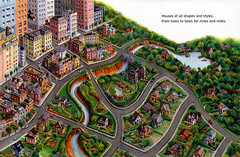Rethinking is required: the more things remain the same, the more opportunities are bobbled: Part One
 Illustration from The House Book by Keith DuQuette.
Illustration from The House Book by Keith DuQuette.The new Dr. Gridlock, Bob Thomson, writes today in the Washington Post. In "A New Beginning for Old Problems," he describes the first Dr. Gridlock's mission:
When Ron Shaffer began "Dr. Gridlock" almost 20 years ago, he described the transportation column's mission like so: "We'll try to find out why bad situations exist and what is being done about them." Complaints began to pour in from readers concerned about double-parking at rush hour, jammed intersections, blocked travel lanes, inadequate highway signs, poor planning and weak enforcement....
"The roads are hopelessly behind the population growth," Ron's readers told him. People wondered why the region had spent billions of dollars on the Metro transit system without providing enough parking for those wanting to use it.
"This column," Ron concluded, "seems to have hit a nerve, with hundreds of people writing to complain about traffic and ask that some problems be examined."
The funny thing is, I responded to that first column with a two page letter. This was long before I got involved in local issues, although I have followed urban issues for a couple decades.
I didn't save the letter, but (as you could imagine) it had about 12 points. One of the major things that Shaffer wrote about was how Beltway repairs were done during rush hour and how this created major backups. He called for the creation of a "Commuters Lobby" to lobby officials on these and other matters... Instead, Dr. Gridlock was born.
But virtually everything he wrote was about the automobile. I responded that he wasn't calling for the creation of a "Commuters Lobby" but a lobby for "Automobile Owners."
One of the points that I remember making was at that time, maybe 1990, WMATA's official policy was that they would not consider extensions to the subway system until the base system was finished. I pointed out that because it takes 8-15 years to fund, design, and construct systems, that this meant it would not be until 2015 maybe, before we would see significant expansions to the system--because the system wasn't due to be finished until about 2000.
He never acknowledged the letter in the column, although the comments did shape something he wrote later, broadening his focus by a smidgen. But by-and-large, as most of us pro-broader thinking about mobility types of written over the years, Dr. Gridlock's focus was always on the automobile.
This brings me to the second point about the third paragraph:
"The roads are hopelessly behind the population growth," Ron's readers told him. People wondered why the region had spent billions of dollars on the Metro transit system without providing enough parking for those wanting to use it.
It's been a long time since I've priced structured parking, but the cost is $20,000 to $30,000/space. Providing parking for transit users isn't really the best use of scarce dollars for "transit". It would take decades to pay this off even with parking fees.
When your thinking is "driven" by "automobility" you have a hard time thinking about alternatives.
Ron Shaffer lives in outer Virginia, and that affected his outlook. Most of the close-in subway stations out of the city, in Arlington and Montgomery Counties, don't have parking, or have little parking. Montgomery County redesigned their RideOn bus service to be able to pick up residents within neighborhoods and transport them to subway stations, without their having to drive. Hence, no need for lots of parking.
This is a completely different way of thinking from Fairfax County, where the stations are not really part of an urban fabric, but forlorn outposts that challenge but must work with "the asphalt nation." (We still have this problem in DC though, I will admit. There has been a strong demand to continue having parking lots at the Rhode Island Metro Station, and this includes Ward 5 resident and member of the Zoning Commission, Anthony Hood.)
This same point about having parking for people to drive to the subway station and park was made in a blog entry in Bacon's Rebellion, the Virginia website-blog. Again, I made the same point, think about alternatives to the car in terms of getting to the subway.
This is my point about transit-shed or mobility-shed planning, about maximizing mobility while reducing single occupancy vehicle trips.
I hope, and there seems to be some evidence from the first new Dr. Gridlock column, that such a broader viewpoint can infuse the this column. On the other hand, it will continue to reflect the concerns of those who write, and most of the people in the region drive...
For past writings on transit-shed/mobility-shed planning, see:
--Purple Line supporter
--The Purple Line and the "Mobility" Shed
--Train wreck or a Land Use and Development Paradigm Wreck?
--Relativistic thinking about mobility
 Think of the rings as being of variable size and representing the "shed" of different forms of mobility used to bring people to and from subway-light rail-transportation centers.
Think of the rings as being of variable size and representing the "shed" of different forms of mobility used to bring people to and from subway-light rail-transportation centers.Index Keywords: mobility; transit



0 Comments:
Post a Comment
<< Home